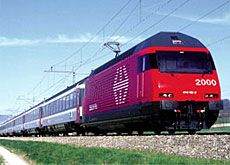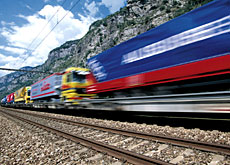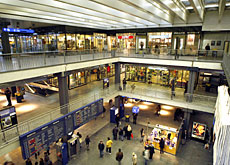Swiss technology key to future of European trains

Switzerland has developed revolutionary technology which will make train journeys safer and quicker, and allow locomotives to operate easily across European borders.
Following successful trials, the Swiss Federal Railways is introducing a high-speed link between Bern and Olten which is to be running by 2005.
The new line, which uses a new type of signalling system, will cut train times between Bern and Zurich to less than an hour.
More significantly, it has brought the technology to a state of readiness for countries across Europe.
“What’s impressive is that the Swiss Federal Railways has got a system to work,” Christopher Garnet, chief executive of Britain’s Great North Eastern Railway, told swissinfo at a recent demonstration of the new equipment.
“We are all watching with interest because that is what the UK will be introducing in four to five years’ time.”
Teething problems
The new system, called cab signalling, involves sending information to the train drivers’ compartment using digital wireless transmission.
The driver gets all the information he needs on a computer inside the cab and knows what is coming up several kilometres ahead, rather than having to rely on traditional lineside signalling.
“Above a certain speed, it is very difficult for the driver to react quickly enough to the lineside signals,” explained David Briginshaw, editor of the International Railway Journal.
“Cab signalling is designed to overcome that so the driver sees what’s happening ahead so he knows in advance when he’s got to brake and when the line’s clear.”
Trials of the European Train Control System (ETCS) on the 35-kilometre stretch of line between Olten and Lucerne – used by 150 trains a day – were plagued with teething problems when they began in April last year.
Swiss Railways says reliability levels are now as high as they were before the scheme began. That means more than 98 per cent of trains arrive on time, which in railway parlance means less than four minutes delay.
About 230 trains a day will be using the new high-speed stretch between Bern and Olten over a distance of 45 kilometres.
State of the art
Traditionally, railways in Europe have tended to have their own electrification and signalling systems.
But the increase in international freight and traffic passenger – a development the European Union is keen to promote – means there is now more emphasis on compatibility.
“The idea of ETCS is to have a system which can be overlaid on the national systems so that you can equip international trains with it and they’re able to run anywhere where ETCS is available,” said Briginshaw.
The European system, being trialled by the Swiss, is far more advanced than the French or German automatic signalling systems for their high-speed trains.
“It will work across all European trains so that when a German or a French train come through Switzerland in two, three, four years’ time, it will have a totally compatible signalling and safety system,” said Garnet.
Five year plan
A third of Switzerland’s 1,500-strong rolling stock is set to be equipped with ETCS by the end of next year.
Within five years, all of the remaining fleet will either have been upgraded to ETCS or will have been replaced by new rolling stock, which carries the cab signalling system.
On the track side, Swiss Federal Railways intends to equip the whole network with ETCS by 2017.
During this period, the company expects to spend about SFr1 billion ($740 million) on the new technology.
swissinfo, Vincent Landon
A third of Switzerland’s rolling stock is set to be equipped with ETCS by the end of 2004.
Within five years, all of the remaining fleet will have been upgraded or replaced.
On the track side, Swiss Federal Railways intends to equip the whole network with ETCS by 2017.
The company expects to spend about SFr1 billion on the new technology.

In compliance with the JTI standards
More: SWI swissinfo.ch certified by the Journalism Trust Initiative


You can find an overview of ongoing debates with our journalists here. Please join us!
If you want to start a conversation about a topic raised in this article or want to report factual errors, email us at english@swissinfo.ch.